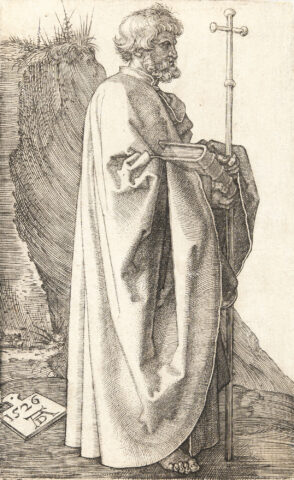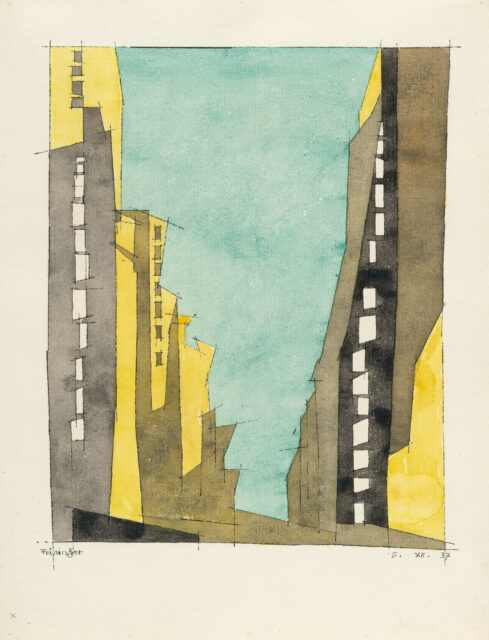
Street in Manhattan
Details
Achim Moeller, director of the Lyonel Feininger Project LLC, New York – Berlin, has confirmed the authenticity of this work, which is registered in the archive of the Lyonel Feininger Project under the number 1887-11-06-23. Certificate enclosed. Provenance: estate of Julia Feininger, New York; private collection, Southern Germany.
Description
• One of Feininger’s first depictions of Manhattan after his return to his homeland of America
• From the estate of his wife Julia
• Feininger repeated the same motif in 1940 in his large-format oil painting “Manhattan I” (100 x 80 cm), which Julia Feininger donated to the Museum of Modern Art, New York in 1964 (inv. no. 259.1964)
With delicate but extremely precise lines drawn with a ruler, Lyonel Feininger captures the perspective of the space between skyscrapers in Manhattan. The incomprehensible dimensions of the skyscrapers extend beyond the edges of the work, the end of the eternally long street is lost in infinity. But above and between them, a magical green-blue sky appears, the façades on the left and right appear alternately in warm yellow sunlight or shadowed metropolitan grey. Not a soul can be seen, only the vertical rows of windows, dancing as if drunk, hint at the life behind them. When this watercolour was painted in December 1937, Feininger had only been living in his native New York for three months, having left the city in 1887 at the age of 16. The sheet bears the tiny note “x” at the bottom left, with which Feininger marked those works that were intended for his wife Julia. Feininger had long hesitated to leave his adopted country of Germany in the previous years, but in 1937 the political situation in Germany worsened, especially for his wife, who was of Jewish descent. In addition, Feininger’s art was defamed in the National Socialist exhibition “Degenerate Art” in Munich in the summer of 1937. In June, Feininger accepted a call to Mills College in Oakland, where he had already taught a summer course the previous year. This time, the now 66-year-old stayed in the USA for good and had to completely reorganise his life. From the beginning of September 1937, Lyonel and Julia Feininger lived in the Earle Hotel on Washington Square in the centre of Manhattan, which still exists today, and in January 1938 they moved a few blocks away to 235 East 22nd Street. In the period that followed, Feininger also began to explore his new surroundings artistically. However, the difference between his beloved architectural motifs from the Old World, the tranquil Thuringian and Pomeranian villages, could hardly be greater. The graphic line can also be found as a unifying, central design element in the Manhattan motifs he now created. In the years that followed, it continued to dominate all of his seemingly minimalist yet complex pictorial compositions. “The form has been reduced to the barest minimum – and the whole apparatus of colour and painting reduced to the simplest – like the ballast that has been thrown off in order to be able to fly freely” (Lyonel Feininger in a letter dated 26 July 1944, quoted from: Hans Hess, Lyonel Feininger, Stuttgart 1959, p. 158).
* All results incl. buyer’s premium (27%) without VAT. No guarantee, subject to error.
** All post-auction prices excl. buyer's premium and VAT. No guarantee, subject to error.
*** Conditional Sale: The bid was accepted below the limit. Acquisition of the work may still be possible in our post-auction sale.
R = regular taxation
N = differential taxation on works of art which originate from a country outside of the EU
The private or commercial use of images shown on this Website, in particular through duplication or dissemination, is not permitted. All rights reserved.
Recently viewed



